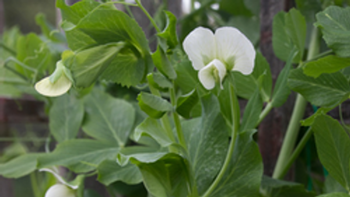Time to plant sweet peas
-
Plant sweet peas in fall, enjoy heavenly fragrance in spring
Sweet peas are, not surprisingly, members of the pea family. Their botanical name is Greek for "pea," Lathyrus odoratus, or fragrant pea. Most peas are edible, but sweet peas are poisonous, and there is even a medical term, lathyrism, to describe the serious consequence of ingesting them. Sweet pea vines appreciate a trellis or arbor. Photo: Terry Nevin
Sweet pea vines appreciate a trellis or arbor. Photo: Terry NevinSweet peas, so called for their sweet scent, are late-comers to our gardens. They were discovered by a Franciscan monk in Sicily, who wrote a description of them in Horus Catholicus in 1697. In 1699, he sent seeds to Robert Uvedale in the United Kingdom. Uvedale was a methodical botanist and one ofthe earliest hothouse owners in Britain. He raised sweet peas in his hothouse initially, but then found them to be hardy outside.
The original blooms, though fragrant, were small and purple. They were painted by Pierre Joseph Redoute, and Thomas Jefferson planted them in an oval bed at Monticello. Still, the flowers didn't become popular until the mid-19th century after they had been improved.
From the five varieties originally available, today there are now 264 varieties in a wide array of colors. When cottage gardens and sweetly scented flowers became the rage, the sweet pea began to enjoy acclaim. Sweet peas come in a wide variety of colors. Photo: Marybeth Kampman
Sweet peas come in a wide variety of colors. Photo: Marybeth KampmanTips for growing sweet peas
Given our mild winters, sweet peas can be sown from November to January. Dig a narrow trench 12 to 18 inches deep to make a rounded seedbed. Refer to the seed packet for proper planting depth. For faster sprouting, soak the seeds or wrap them in a wet paper towel overnight.Sweet pea vines should be supported on a trellis or fence. Fertilize monthly to keep plants flowering. The trick to keep the vines producing their fragrant blooms until July is to cut often to keep pods from forming. When the inevitable last flowers are gone, be patient about removing the plants too soon. Allow the pods to mature so you can save the seeds for next year.
Lacking a fence or lean-to device, you might consider a dwarf variety. The plants form a bush about 2 feet tall and can offer color and fragrance along a path or border. All directions for planting and fertilizing are the same as for the vine sweet peas. Remember to dry and save the seeds for the next year.


